Related Research Articles
Antiochus is a Greek male first name, which was a dynastic name for rulers of the Seleucid Empire and the kingdom of Commagene. In Jewish historical memory, connected with the Maccabean Revolt and the holiday of Hanukkah, "Antiochus" refers specifically to Antiochus IV Epiphanes.
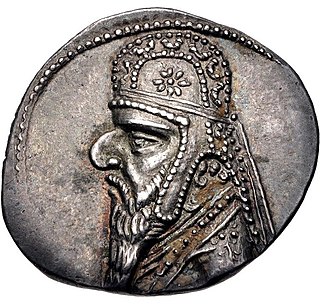
Mithridates II was king of the Parthian Empire from 124 to 91 BC. Considered one of the greatest of his dynasty to ever rule, he was known as Mithridates the Great in antiquity.

Demetrius III Theos Philopator Soter Philometor Euergetes Callinicus was a Hellenistic Seleucid monarch who reigned as the King of Syria between 96 and 87 BC. He was a son of Antiochus VIII and, most likely, his Egyptian wife Tryphaena. Demetrius III's early life was spent in a period of civil war between his father and his uncle Antiochus IX, which ended with the assassination of Antiochus VIII in 96 BC. After the death of their father, Demetrius III took control of Damascus while his brother Seleucus VI prepared for war against Antiochus IX, who occupied the Syrian capital Antioch.
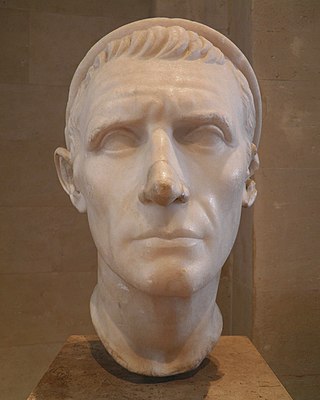
Antiochus III the Great was a Greek Hellenistic king and the 6th ruler of the Seleucid Empire, reigning from 222 to 187 BC. He ruled over the region of Syria and large parts of the rest of western Asia towards the end of the 3rd century BC. Rising to the throne at the age of eighteen in 222 BC, his early campaigns against the Ptolemaic Kingdom were unsuccessful, but in the following years Antiochus gained several military victories and substantially expanded the empire's territory. His traditional designation, the Great, reflects an epithet he assumed. He also assumed the title Basileus Megas, the traditional title of the Persian kings. A militarily active ruler, Antiochus restored much of the territory of the Seleucid Empire, before suffering a serious setback, towards the end of his reign, in his war against Rome.
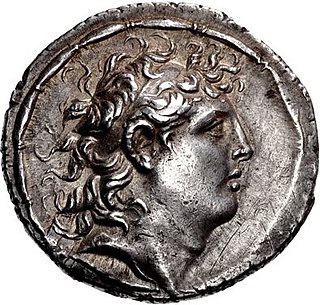
Diodotus Tryphon, nicknamed "The Magnificent" was a Greek king of the Seleucid Empire. Initially an official under King Alexander I Balas, he led a revolt against Alexander's successor Demetrius II Nicator in 144 BC. He rapidly gained control of most of Syria and the Levant. At first, he acted as regent and tutor for Alexander's infant son Antiochus VI Dionysus, but after the death of his charge in 142/141 BC, Diodotus declared himself king. He took the royal name Tryphon Autocrator and distanced himself from the Seleucid dynasty. For a period between 139 and 138, he was the sole ruler of the Seleucid empire. However, in 138 BC Demetrius II's brother Antiochus VII Sidetes invaded Syria and brought his rule to an end.
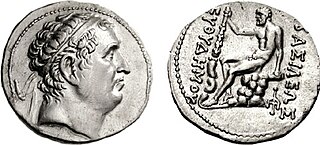
Euthydemus I c. 260 BC – 200/195 BC) was a Greco-Bactrian king and founder of the Euthydemid dynasty. He is thought to have originally been a satrap of Sogdia, who usurped power from Diodotus II in 224 BC. Literary sources, notably Polybius, record how he and his son Demetrius resisted an invasion by the Seleucid king Antiochus III from 209 to 206 BC. Euthydemus expanded the Bactrian territory into Sogdia, constructed several fortresses, including the Derbent Wall in the Iron Gate, and issued a very substantial coinage.
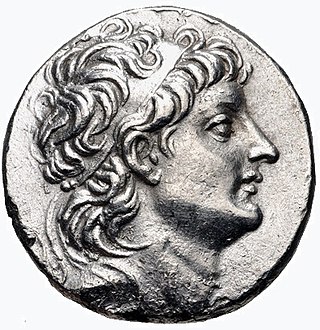
Alexander II Theos Epiphanes Nikephoros was a Hellenistic Seleucid monarch who reigned as the King of Syria between 128 BC and 123 BC. His true parentage is debated; depending on which ancient historian, he either claimed to be a son of Alexander I or an adopted son of Antiochus VII. Most ancient historians and the modern academic consensus maintain that Alexander II's claim to be a Seleucid was false. His surname "Zabinas" (Ζαβίνας) is a Semitic name that is usually translated as "the bought one". It is possible, however, that Alexander II was a natural son of Alexander I, as the surname can also mean "bought from the god". The iconography of Alexander II's coinage indicates he based his claims to the throne on his descent from Antiochus IV, the father of Alexander I.

Antiochus X Eusebes Philopator was a Seleucid monarch who reigned as King of Syria during the Hellenistic period between 95 BC and 92 BC or 89/88 BC. He was the son of Antiochus IX and perhaps his Egyptian wife Cleopatra IV. Eusebes lived during a period of general disintegration in Seleucid Syria, characterized by civil wars, foreign interference by Ptolemaic Egypt and incursions by the Parthians. Antiochus IX was killed in 95 BC at the hands of Seleucus VI, the son of his half-brother and rival Antiochus VIII. Antiochus X then went to the city of Aradus where he declared himself king. He avenged his father by defeating Seleucus VI, who was eventually killed.

Antiochus XI Epiphanes Philadelphus was a Seleucid monarch who reigned as King of Syria between 94 and 93 BC, during the Hellenistic period. He was the son of Antiochus VIII and his wife Tryphaena. Antiochus XI's early life was a time of constant civil war between his father and his uncle Antiochus IX. The conflict ended with the assassination of Antiochus VIII, followed by the establishment of Antiochus IX in Antioch, the capital of Syria. Antiochus VIII's eldest son Seleucus VI, in control of western Cilicia, marched against his uncle and had him killed, taking Antioch for himself, only to be expelled from it and driven to his death in 94 BC by Antiochus IX's son Antiochus X.

Mithridates I, also known as Mithridates I the Great, was king of the Parthian Empire from 165 BC to 132 BC. During his reign, Parthia was transformed from a small kingdom into a major political power in the Ancient East as a result of his conquests. He first conquered Aria, Margiana and western Bactria from the Greco-Bactrians sometime in 163–155 BC, and then waged war with the Seleucid Empire, conquering Media and Atropatene in 148/7 BC. In 141 BC, he conquered Babylonia and held an official investiture ceremony in Seleucia. The kingdoms of Elymais and Characene shortly afterwards became Parthian vassals. In c. 140 BC, while Mithridates was fighting the nomadic Saka in the east, the Seleucid king Demetrius II Nicator attempted to regain the lost territories; initially successful, he was defeated and captured in 138 BC, and shortly afterwards sent to one of Mithridates I's palaces in Hyrcania. Mithridates I then punished Elymais for aiding Demetrius, and made Persis a Parthian vassal.

Phraates II was king of the Parthian Empire from 132 BC to 127 BC. He was the son and successor of Mithridates I.

Elymais or Elamais was an autonomous state of the 2nd century BC to the early 3rd century AD, frequently a vassal under Parthian control. It was located at the head of the Persian Gulf in Susiana. Most of the population probably descended from the ancient Elamites, who once had control of that area.

Characene, also known as Mesene (Μεσσήνη) or Meshan, was a kingdom founded by the Iranian Hyspaosines located at the head of the Persian Gulf mostly within modern day Iraq. Its capital, Charax Spasinou, was an important port for trade between Mesopotamia and India, and also provided port facilities for the city of Susa further up the Karun River. The kingdom was frequently a vassal of the Parthian Empire. Characene was mainly populated by Arabs, who spoke Aramaic as their cultural language. All rulers of the principality had Iranian names. Members of the Arsacid dynasty also ruled the state.
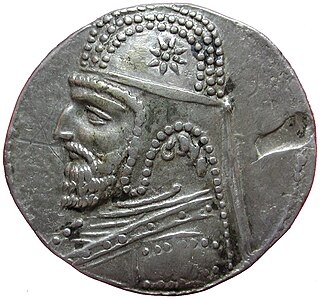
Orodes I, was king of the Parthian Empire from 80 to 75 BC. He was the son and heir of Gotarzes I. His reign is relatively obscure. His throne may have been usurped in 87–80 BC by his supposed uncle Mithridates III, however, this has found little support in scholarship. Of his military activities, it is known that Orodes I re-established Parthian rule in Elymais in 78 BC, which had been independent since 81/80 BC. Orodes I later lost the throne to the aged Parthian prince Sinatruces, who belonged to a different branch of the royal Arsacid family.

The Staatliches Museum Ägyptischer Kunst is an archaeological museum in Munich. It contains the Bavarian state collection of ancient Egyptian art and displays exhibits from both the predynastic and dynastic periods. The associated small Middle East section displays objects from the areas of Assyrian and Babylonian culture. For decades, the Egyptian museum was located in the Munich Residenz, but it was moved to the Kunstareal in June 2013.

Autokrator or Autocrator is a Greek epithet applied to an individual who is unrestrained by superiors. It has been applied to military commanders-in-chief as well as Roman and Byzantine emperors as the translation of the Latin title imperator. Its connection with Byzantine-style absolutism gave rise to the modern terms autocrat and autocracy. In Modern Greek, it means "emperor", and its feminine form is autokráteira (αὐτοκράτειρα).

Tiraios II was a king who ruled from about 79/78 to 49/48 BC the state of Characene, a vassal state of the Parthians.

Kamnaskires II, surnamed Nikephoros was a king of the Elymais only known from his coins. He reigned from about 147 to 139 BC. Around 150 BC, the Seleucid empire disintegrated and at several places local governors became independent and assumed the title of "king" (basileus). The first king in the Elymais was Kamnaskires Soter, who ruled around 147 BC. Kamnaskires II Nikephoros ruled slightly later and it is possible that he was identical with Kamnaskires Soter, just changing his name. In 140 BC, Kamnaskires II accepted Parthian suzerainty. However, not long after, Kamnaskires II aided the Seleucid ruler Demetrius II Nicator against the Parthian monarch Mithridates I. However, Demetrius was eventually defeated and captured by the Parthians. Mithridates I then punished Elymais for aiding the Seleucids–he invaded the region once more and captured two of their major cities.

Frataraka is an ancient Persian title, interpreted variously as “leader, governor, forerunner”. It is an epithet or title of a series of rulers in Persis from 3rd to mid 2nd century BC, or alternatively between 295 and 220 BC, at the time of the Seleucid Empire, prior to the Parthian conquest of West Asia and Iran. Studies of frataraka coins are important to historians of this period.
References
- ↑ G. R. F. Assar: "A New Hellenistic Ruler from Early 1st Century BC: King [Hip]pokrates Autokrator Nikephoros", in: Portraits: 400 Years of Hellenistic Portraits/400 Jahre hellenistische Portraits. Staatliche Münzsammlung München. Editor/Herausgeber: Dr. Andreas Pangerl. Publisher: Verlag: Staatliche Münzsammlung München, Munich 2020. ISBN 978-3-922840-41-1, pp. 339–343
- ↑ G. R. F. Assar: "A New Hellenistic Ruler from Early 1st Century BC: King [Hip]pokrates Autokrator Nikephoros", in: Portraits: 400 Years of Hellenistic Portraits/400 Jahre hellenistische Portraits. Staatliche Münzsammlung München. Editor/Herausgeber: Dr. Andreas Pangerl. Publisher: Verlag: Staatliche Münzsammlung München, Munich 2020. ISBN 978-3-922840-41-1, pp. 339–343
- ↑ Kay Ehling, Andreas Pangerl, Julian Wünsch: "Hippokrates, ein neuer Seleukidenkönig", Jahrbuch für Numismatik und Geldgeschichte 69/70 2020, pp. 35–48